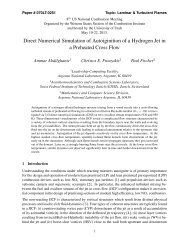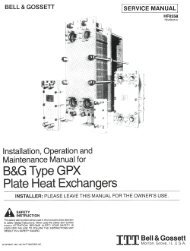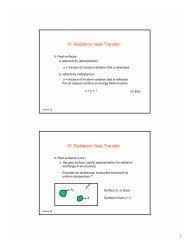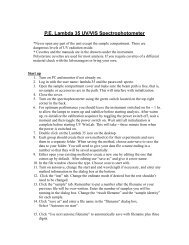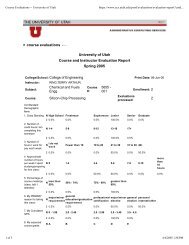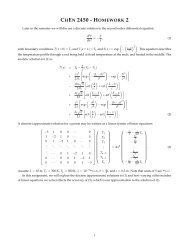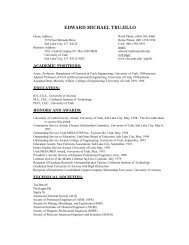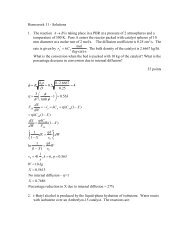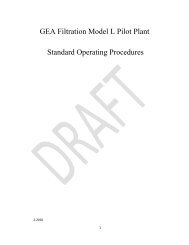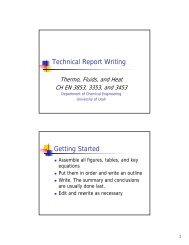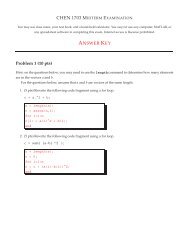7988 CANNON-FENSKE VISCOMETER Instructions
7988 CANNON-FENSKE VISCOMETER Instructions
7988 CANNON-FENSKE VISCOMETER Instructions
Create successful ePaper yourself
Turn your PDF publications into a flip-book with our unique Google optimized e-Paper software.
<strong>7988</strong><br />
<strong>CANNON</strong>-<strong>FENSKE</strong> <strong>VISCOMETER</strong><br />
<strong>Instructions</strong><br />
1. The viscometer should be cleaned<br />
with a suitable solvent and dried in<br />
a stream of clean, filtered or N 2<br />
.<br />
2. The instrument should be periodically<br />
cleaned with chromic acid<br />
o remove any possible traces of<br />
organic deposits.<br />
3. If a possibility of lint, dust, or other<br />
solid material is present in the liquid<br />
sample, this may be removed<br />
by filtering through sintered glass<br />
filter or fine mesh screen. (NB:<br />
This may not be feasible with<br />
crude oils.)<br />
4. To introduce sample into the<br />
viscometer, invert viscometer,<br />
immerse tube “A” into liquid and<br />
apply suction to “I”, which causes<br />
the sample to rise to etched line<br />
“E”. Turn the viscometer to normal<br />
position and wipe tube “A” clean.<br />
5. Insert the viscometer into a holder<br />
and place in constant temperature<br />
bath. Allow 10 minutes for<br />
viscometer to reach equilibrium at<br />
100°F (38°C) or 15 min at 210°F<br />
(98.89°C), or what ever amount<br />
of time is required for temperature<br />
equilibration.<br />
6. Vertical alignment may be ac<br />
complished in bath by suspending<br />
a plumb bob in tube “I”.<br />
7. Apply suction to tube “A” and<br />
bring sample into bulb “B” a<br />
short distance above mark “C”.<br />
8. The efflux time is measured<br />
by allowing the sample to flow<br />
freely through mark “C”, measuring<br />
the time for the meniscus<br />
to pass from “C” to “E”.<br />
9. To repeat efflux time measurement,<br />
repeat steps 7 and 8.<br />
10. The kinematic viscosity is calculated<br />
by multiplying the efflux<br />
time by the viscometer constant.<br />
dynamic viscosity (cP) = kinematic<br />
viscosity (cSt) × density<br />
(g/cm 3 )<br />
See ASTM D445 and D2515 for more complete instructions.
It is particularly important to remember the following points:<br />
(1) Use the correct viscometer size. Measuring ranges overlap, but the best results will be<br />
obtained if you are operating near the center of the viscometer’s range. If your sample has<br />
aviscosity of about 100 cSt, for example, the size 300 (range 50-250 cSt) viscometer will<br />
give more accurate results than either size 200 (range 20-100 cSt) or size 350 (range 100-<br />
500cSt).<br />
Refer to the table below as a guide to size selection.<br />
Recommended Viscosity Ranges for Cannon-Fenske Routine Viscometers<br />
viscosity range (cSt)<br />
Approx.<br />
Constant Centi-<br />
Range<br />
Size stokes/Sec. Centistokes<br />
25 0.002 0.5 to 2<br />
50 0.004 0.8 to 4<br />
75 0.008 1.6 to 8<br />
100 0.015 3 to 15<br />
150 0.035 7 to 35<br />
200 0.1 20 to 100<br />
300 0.25 50 to 250<br />
350 0.5 100 to 500<br />
400 1.2 240 to 1200<br />
450 2.5 500 to 2500<br />
500 8 1600 to 8000<br />
600 20 4000 to 20000<br />
650 45 9000 to 45000<br />
700 100 20000 to 100000<br />
(2) Avoid overloading the viscometer. Using either too much or too little sample will produce<br />
inaccurate values of viscosity. The volume that fills the tube from E to the inlet of the A<br />
tube will approximately half fill the bulb marked H.<br />
(3) Use the correct calibration factor, C. Each viscometer comes with its own serial number<br />
and calibration constants, which vary from one instrument to another. Note that the constants<br />
listed in the table above are only approximate values. The constant varies with<br />
temperature and applies only if the correct amount of fluid has been charged into the<br />
viscometer. If the calibration constants have been lost, they can be redetermined using<br />
viscosity standards.<br />
(4) After loading the sample, wait at least 10 minutes before making measurements. Some<br />
time is required to allow the sample to equilibrate at the temperature of the water bath<br />
and to allow air bubbles to seggregate.<br />
(5) Use special methods for opaque samples. For high viscosity oil samples, which are<br />
sometimes quite opaque, it is often necessary to use auxiliary illumination to improve<br />
judgments of the passage of the interface past the starting and ending marks. Another<br />
option is to use a “reverse flow” viscometer.



